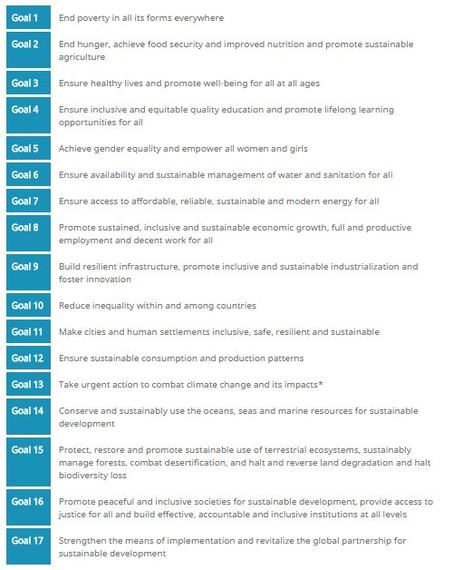For 15 years, the world community has worked to achieve a comprehensive set of goals and targets called the Millennium Development Goals (MDGs) - launched in 2000 to tackle poverty, economic and environment inequity, and strategies for effective development. The MDGs concluded this year, and a new set of goals to replace them have been in design and negotiation for some time. These new objectives - now called Sustainable Development Goals (SDGs) - are now final, offering global priorities for sustainable development beyond 2015. Figure 1 lists the 17 overarching SDGs. Each one is accompanied by specific targets and measured by specific indicators. Individual governments will be responsible for setting their own specific national targets based on their own priorities and circumstances.
While the major overarching objective is the eradication of poverty, the SDGs cover a lot of ground, including changing unsustainable (and promoting sustainable) patterns of consumption and production, and protecting and managing the natural resource base. Readers should look at the comprehensive list of goals and the more detailed set of targets, but for those especially interested in the subject of global freshwater, there is a subset of goals and targets. This summary lists those by Goal and Target related to water.
- 3.3: by 2030 end the epidemics of AIDS, tuberculosis, malaria, and neglected tropical diseases and combat hepatitis, water-borne diseases, and other communicable diseases
- 3.9: by 2030 substantially reduce the number of deaths and illnesses from hazardous chemicals and air, water, and soil pollution and contamination
- 6.1 by 2030, achieve universal and equitable access to safe and affordable drinking water for all
- 6.2 by 2030, achieve access to adequate and equitable sanitation and hygiene for all, and end open defecation, paying special attention to the needs of women and girls and those in vulnerable situations
- 6.3 by 2030, improve water quality by reducing pollution, eliminating dumping and minimizing release of hazardous chemicals and materials, halving the proportion of untreated wastewater, and increasing recycling and safe reuse by x% globally
- 6.4 by 2030, substantially increase water-use efficiency across all sectors and ensure sustainable withdrawals and supply of freshwater to address water scarcity, and substantially reduce the number of people suffering from water scarcity
- 6.5 by 2030 implement integrated water resources management at all levels, including through transboundary cooperation as appropriate
- 6.6 by 2020 protect and restore water-related ecosystems, including mountains, forests, wetlands, rivers, aquifers and lakes
- 6.a by 2030, expand international cooperation and capacity-building support to developing countries in water and sanitation related activities and programmes, including water harvesting, desalination, water efficiency, wastewater treatment, recycling and reuse technologies
- 6.b support and strengthen the participation of local communities for improving water and sanitation management
Goal 11. Make cities and human settlements inclusive, safe, resilient and sustainable
11.5 by 2030 significantly reduce the number of deaths and the number of affected people and decrease by y% the economic losses relative to GDP caused by disasters, including water-related disasters, with the focus on protecting the poor and people in vulnerable situations.
- 12.4 by 2020 achieve environmentally sound management of chemicals and all wastes throughout their life cycle in accordance with agreed international frameworks and significantly reduce their release to air, water and soil to minimize their adverse impacts on human health and the environment
- 15.1 by 2020 ensure conservation, restoration and sustainable use of terrestrial and inland freshwater ecosystems and their services, in particular forests, wetlands, mountains and drylands, in line with obligations under international agreements
- 15.8 by 2020 introduce measures to prevent the introduction and significantly reduce the impact of invasive alien species on land and water ecosystems, and control or eradicate the priority species


